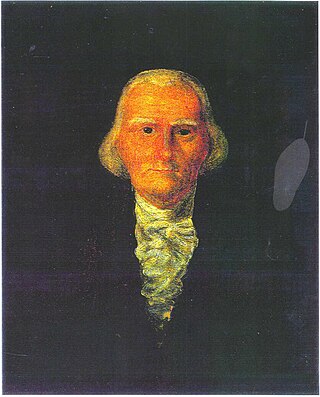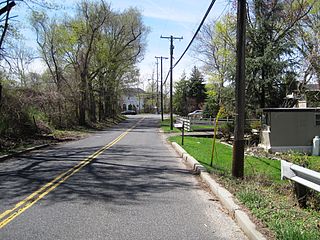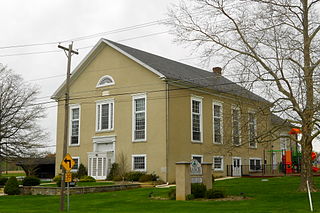
Gilbert Tennent was a Presbyterian revivalist minister in Colonial America. Born into a Scotch-Irish family in County Armagh, Ireland, he migrated to America with his parents, studied theology, and along with Jonathan Edwards and George Whitefield, became one of the leaders of the evangelical revival known as the First Great Awakening. His most famous sermon, On the Danger of an Unconverted Ministry, also known as the "Nottingham Sermon," compared "Old Side" ministers to the biblical Pharisees of the Gospels, triggering a schism in the Presbyterian Church which lasted for 17 years. A prolific writer, Tennent would later work towards reunification of the two synods involved.
Warrenton Presbyterian Church is a Presbyterian Church (USA) congregation located at 133 Watts Road near Abbeville in Abbeville County, South Carolina.

The First Presbyterian Church and Cemetery in New Brunswick, New Jersey is one of the oldest churches in the Presbyterian denomination. It was the seat of the Presbytery of New Brunswick which is now located in Trenton, New Jersey.

William Tennent was an early Scottish American Presbyterian minister and educator in British North America.

The Log College, founded in 1727, was the first theological seminary serving Presbyterians in North America, and was located in what is now Warminster, Pennsylvania. It was founded by William Tennent and operated from 1727 until Tennent's death in 1746, and it graduated proponents on the New Side of the significant Old Side–New Side Controversy that divided presbyterianism in colonial America at the time. The Log College was, as a physical structure, very plain, according to George Whitefield's journal; it was a private institution that had no charter. At that time, ministers could not get ordained unless they had graduated from Harvard, Yale, or a college in England. Thus, an important purpose in its founding was to support the spread of New Light Christianity by enabling proponents to become ordained. In sources dated through the early 20th century, it was referred to as a remarkable institution, with graduates including Samuel Finley, John Redman, and John Rowland. Though the number of eventual graduates is unknown, many would play important roles in the Old Side–New Side Controversy, and Log College alumni Samuel Blair, Samuel Finley, and William Tennent, Jr. would become trustees of a newly formed College of New Jersey, which would be renamed Princeton University in 1896.

Wickatunk is an unincorporated community located within Marlboro Township in Monmouth County, in the U.S. state of New Jersey. Elevation above sea level is 180 feet (55 m). It was founded in 1695 by three Scottish servants from the community of Toponemus. Originally surveyed by George Keith, in a letter he states:
"After some time I may give thee a particular account of all thy land I have surveyed for thee and what I reckon dew for it. John Laing and his family are well and lyke to do well, and so John Sym and his family. Also thou hast thy share laid out at Wickington (Wickatunk).
John Thomson or Thompson was born in Ireland and became a minister in the Presbytery of Philadelphia, later the Synod of Philadelphia. He served as a missionary in both Virginia and North Carolina, where he died a natural death in 1753. He is buried in the cemetery of Centre Presbyterian Church in Mooresville, North Carolina.
The Old Side–New Side controversy occurred within the Presbyterian Church in Colonial America and was part of the wider theological controversy surrounding the First Great Awakening. The Old and New Side Presbyterians existed as separate churches from 1741 until 1758. The name of Old Side–New Side is usually meant as specifically referring to the Presbyterian Church. When one is referring to the debate as a whole, Old and New Light is usually used.

James Clark was the fifth president of Washington College
John Brackenridge was a Presbyterian minister who served as Chaplain of the United States House of Representatives and Chaplain of the United States Senate.
John Cairns (1857–1922) was a United Presbyterian Church minister, writer and biographer. He was born on 13 April 1857 at Stichill in Roxburghshire. He was the son of Rev. David Cairns, United Presbyterian Church minister at Stichill, and of Elizabeth Williamson Smith. He was educated at Edrom Parish School in Berwickshire and at University of Edinburgh where he graduated M.A. in 1878. He trained for the ministry at United Presbyterian College, Edinburgh and at Leipzig University. He wrote a biography of his uncle, John Cairns in the "Famous Scots Series". He died in Edinburgh on 13 May 1922.
Marlboro Township, New Jersey has a number of historic sites. The Monmouth County Historic Site Inventory (HSI) was started in 1980 by the directors of both the Monmouth County Historical Association and the Monmouth County Park System. This inventory project provided an inventory number to all historic properties in Monmouth County, New Jersey. In addition to property details, this listing provides reference numbers for easy identification. In addition to the park system inventory, the Marlboro Township Historic Commission provides a listing of Historic Commission Landmarks (HCL). These are physical signs placed in historically significant locations. There was also a list presented by the NJ Department of Environmental Protection - Historic Preservation Office (HPO).

The Old Scots Burying Ground is a historic cemetery located on Gordon's Corner Road in the Wickatunk section of Marlboro Township, in Monmouth County, New Jersey. It was added to the National Register of Historic Places on August 15, 2001, for its significance in history and religion. The Old Scots Burying Ground is about an acre in size, about 195 feet above sea level and dates back to 1685. The total number of burials at the cemetery is not precisely known, suggested by Symms, "There are a large number of graves in Old Scots yard without any inscribed stones". Some reports place the number as at least 100 known graves with most headstones of brown sandstone. However, more recent research using ground penetrating radar reported by the Old Tennent Church in 2001 has put the number of confirmed sites at about 122 graves with a possible 140 more unmarked; placing the number at about 262 total graves in the cemetery. In 1945, in an attempt to clean out the site of vegetation and over-growth, a bulldozer was used on the property and as a result some headstones were dislodged and broken stones removed. The defining structure in the cemetery is a tall monument to Rev. John Boyd, created by the J&R Lamb Company. Built to commemorate the first recorded Presbyterian ordination of Rev. John Boyd. The monument is currently owned by the Synod of the Northeast who holds the property deed but it is maintained by the Old Tennent Church. The last identified burial was in 1977.

John Blair was a Presbyterian minister, a Trustee, Professor, and Acting President of Princeton University. His brother Samuel Blair was a leader of the Presbyterian New Light religious movement. His nephew, Samuel Blair was the second Chaplain of the United States House of Representatives.

Daniel Veech McLean was a Presbyterian minister and the fifth president of Lafayette College.

Rev Archibald Riddell (1635–1708) was a Scots-born 17th-century Presbyterian church minister in Scotland and America. His name is sometimes spelled Riddel. He preached at conventicles in a time when such actions were considered high treason. He was imprisoned on the Bass Rock and was later banished to New Jersey.
William Tennent III was a Presbyterian pastor and South Carolina politician. He was born and educated in northern Colonial America, but spent the latter part of his life in the southern state of South Carolina. He was a prominent advocate for the dis-establishment of any state religion. He is known for his opposition to British colonial policy, publishing patriotic essays in support of the revolution. He was selected to travel in 1775 into the "back county" of South Carolina to convert Loyalists to the cause. In the state assembly, he lobbied for religious liberty in the drafting of state constitutions.

John M'Millan was the founding Father of the Reformed Presbyterian Church. He was the first minister of the Cameronians after the Revolution Settlement. He was born at Minnigaff, near Newton Stewart in Kirkcudbrightshire, around 1669, and spent his boyhood near his birthplace. Before he began his ministerial career he was elected an elder of Girthon session. He attended Edinburgh University 1695-7, and graduated with an M.A. on 28 June 1697. He was licensed on 26 November 1700, spending part of his probation as tutor with the Laird of Broughton, 1700-1. He preached for the first time in Balmaghie Church on 22 December 1700, apparently as ordinary supply, and on 30 April 1701, was elected to the parish. The call was reported to the Presbytery on 24 June, and he was ordained on 19 September. The controversy regarding his ecclesiastical attitude lasted from October 1702 to 30 December 1703, when he was deposed. His name first appears in the minutes of the General Meeting of the Dissenters when they considered a letter from him, 5 April 1704. He conferred with its members on 31 January 1705, and 13 February 1706, and on 14 August 1706, submitted to them. The Societies called him on 9 October. The Covenants were renewed at Auchensaugh on 23–4 July 1712. M'Millan left the Balmaghie Manse in 1727, and during 1729-34 resided at different places in the parish of Carnwath, and at Braehead from 1734 to 1753. The Presbytery was erected at Braehead on 1 August 1743, and a disruption took place in it in April 1753. He died at Broomhill on 1 December 1753.
Angus McBean, or as he was otherwise known by his family Æneas McBean was a Scottish minister and Covenanter. He was the last Presbyterian minister deposed under Episcopacy.
Rev. William Dean was an Irish born Presbyterian clergyman and Evangelist Old Side minister who was best known as “the apostle of Virginia." In 1745 he became one of the first ministers to lead revivals to slaves, Native Americans and poor farmers in the Virginia Valley including at Rockbridge, Augusta County, and the James River. Upon his death, Samuel Davies resumed his work in Virginia from 1748 - 1749.










